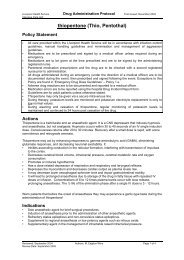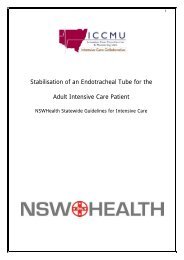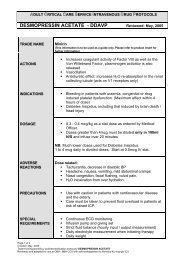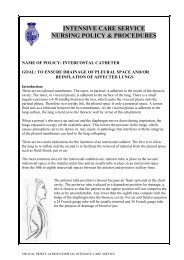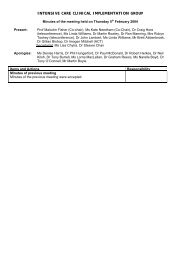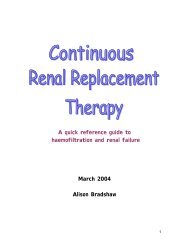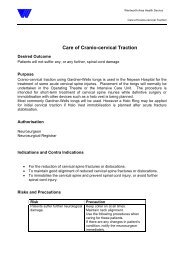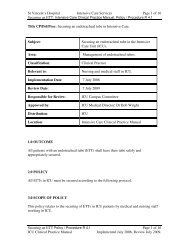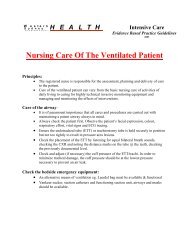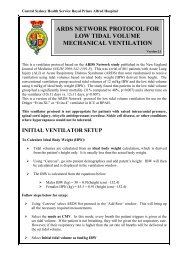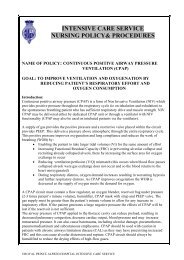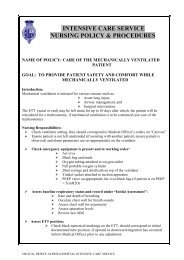Desmopressin - Intensive Care & Coordination Monitoring Unit
Desmopressin - Intensive Care & Coordination Monitoring Unit
Desmopressin - Intensive Care & Coordination Monitoring Unit
Create successful ePaper yourself
Turn your PDF publications into a flip-book with our unique Google optimized e-Paper software.
Liverpool Health Service Drug Administration Protocol First Issued February 2002<br />
<strong>Intensive</strong> <strong>Care</strong> <strong>Unit</strong><br />
Policy Statement<br />
desmopressin (DDAVP, Minirin, Octostim)<br />
All care provided within the Liverpool Health Service will be in accordance with infection control<br />
guidelines, manual handling guidelines and minimisation and management of aggression<br />
guidelines.<br />
Medications are to be prescribed and signed by a medical officer unless required during an<br />
emergency.<br />
Medications are to be given at the time prescribed and are to be signed by the administering<br />
registered nurse.<br />
Parenteral medication prescriptions and the drug are to be checked with a second registered<br />
nurse prior to administration.<br />
Infection Control guidelines are to be followed.<br />
All drugs administered during an emergency (under the direction of a medical officer) are to be<br />
documented during the event, then prescribed and signed following the event. Exceptions to this<br />
Policy are found in ‘Emergency Drug Dose Guidelines’ – Policy 1.e.<br />
Adverse drug reactions are to be documented and reported to a medical officer.<br />
Medication errors are to be reported using the hospital Drug Incident Report form.<br />
Guidelines are for adult patients unless otherwise stated.<br />
Formal diagnosis of DI will be made based upon serum and urine osmolality (not upon<br />
large diuresis) prior to administration of vasopressin.<br />
Not for use in Type II von Willebrand’s Disease.<br />
• Intravenous fluid administration must be reviewed to avoid overhydration.<br />
Actions<br />
<strong>Desmopressin</strong> is a posterior pituitary hormone, known as ADH: antidiuretic hormone.<br />
The drug is a synthetically manufactured form of the natural hormone ‘arginine vasopressin’ with<br />
major differences being a three to five-fold increase in antidiuretic activity and an almost absent<br />
pressor effect.<br />
<strong>Desmopressin</strong> acts in the renal tubule to increase water reabsorption.<br />
High doses of desmopressin produce marked, sustained increases in Factor VIII coagulant<br />
activity (VIII:C) and increases in von Willebrand factor (vWF). There is release of plasminogen<br />
activator.<br />
There is slight stimulation of uterine activity in non-pregnant women at doses of 15 – 20<br />
micrograms intranasally.<br />
At doses to treat bleeding, desmopressin has a vasodilatory effect, causing minor decreases in<br />
systolic and diastolic BP.<br />
When given IV, IM or SC the majority of the drug is available, whereas intranasally only 10% is<br />
available. Thus IV, IM, SC doses are one tenth of the intranasal route.<br />
There is varied duration of effect, ranging outside 8 – 20 hours of effect.<br />
Indications<br />
Pituitary diabetes insipidus (not Nephrogenic).<br />
Post hypophysectomy (pituitary surgery) temporary or permanent injury.<br />
The treatment of ADH sensitive cranial diabetes insipidus, including treatment of<br />
posthypophysectomy polydipsia and polyuria.<br />
Diagnostic test to establish renal concentrating capacity.<br />
Mild and moderate haemophilia A and von Willebrand's disease.<br />
To increase factor VIII levels in patients undergoing dental or minor surgery.<br />
Bleeding in patients with platelet dysfunction.<br />
Treatment of excessive bleeding in patients with congenital or acquired clinical conditions<br />
associated with platelet dysfunction, which is characterized by a prolonged bleeding time.<br />
Patients undergoing cardiac surgery with cardiopulmonary bypass for prosthetic valve<br />
replacement or aortocoronary bypass grafting, especially when it is complicated by platelet<br />
function defects sufficient to prolong bleeding time despite relatively normal platelet cover.<br />
Reviewed: September 2004 Authors: M. Edgtton-Winn Page 1 of 1<br />
Review Date: September 2005
Liverpool Health Service Drug Administration Protocol First Issued February 2002<br />
<strong>Intensive</strong> <strong>Care</strong> <strong>Unit</strong><br />
Contraindications<br />
Type IIB von Willebrand's disease.<br />
Habitual and psychogenic polydipsia.<br />
Cardiac insufficiency and other conditions requiring treatment with diuretic agents.<br />
Hypersensitivity to the preservative.<br />
<strong>Desmopressin</strong> is ineffective for the treatment of nephrogenic diabetes insipidus.<br />
Precautions<br />
Overhydration, especially with children, the elderly, when used with concurrent fluid replacement.<br />
Patients with a history of cardiac failure and when used to test renal concentrating ability.<br />
Excessive water intake or chronic use of desmopressin can produce hyponatraemia with<br />
associated effects.<br />
When desmopressin is used for diagnostic purposes, the fluid intake must be limited and not<br />
exceed 0.5 litres from one hour before until eight hours after administration.<br />
<strong>Desmopressin</strong> should not be administered to dehydrated or overhydrated patients until water<br />
balance has been adequately restored.<br />
In haemophilia, where high doses are given, extreme care must be paid to the water balance.<br />
Fluid intake should be restricted as much as possible and the patient should be weighed<br />
regularly.<br />
Not for intransal administration if rhinorrhoea or local infection exists.<br />
Use with caution in patients with cystic fibrosis because of impaired water handling and increased<br />
risk of hyponatraemia.<br />
Use with caution in patients at risk of increased intracranial pressure secondary to fluid retention.<br />
Significant Interactions<br />
Tricyclic antidepressants, chlorpromazine and carbamazepine may cause an additive antidiuretic<br />
effect and increase the risk of water retention.<br />
Indomethacin may augment the magnitude but not the duration of the response to desmopressin.<br />
Glibenclamide inhibits the antidiuretic effect of desmopressin.<br />
Clofibrate has potentiated and prolonged the effects of desmopressin.<br />
Adverse Effects<br />
Tachycardia, fall in diastolic blood pressure by 10 to 20% with large IV doses.<br />
Hypertension.<br />
Headache, nausea, mild abdominal cramp, vomiting.<br />
Nasal congestion, facial flushing, vulval pain.<br />
Water intoxication from overhydration, hyponatraemia.<br />
Presentation<br />
Intranasal solution, 100 micrograms/mL, 2.5mL dropper bottle plus rhinyle (Minirin).<br />
Injection, 4 micrograms/mL in 1mL ampoule (DDAVP).<br />
Injection, 15 micrograms/mL in 1mL ampoule (Octostim) for intravenous use only.<br />
Reviewed: September 2004 Authors: M. Edgtton-Winn Page 2 of 2<br />
Review Date: September 2005
Liverpool Health Service Drug Administration Protocol First Issued February 2002<br />
<strong>Intensive</strong> <strong>Care</strong> <strong>Unit</strong><br />
Administration Guidelines<br />
ADH sensitive cranial diabetes insipidus:<br />
Adults.<br />
Intranasally 5 to 20 micrograms twice daily, adjusted for adequate sleep patterns.<br />
IV, IM or SC slow injection, undiluted using a diabetic syringe. Administer 0.5 – 1.0 microgram which<br />
may require bd or tds dosage.<br />
Dosage is controlled by measurement of serum and urine osmolality.<br />
A single daily dose may be used if tolerated and provides control of the diabetes insipidus.<br />
Paediatric.<br />
Intranasally 1.25 to 10 micrograms twice daily.<br />
IV, IM or SC up to 200 nanograms twice daily as a slow, injection using a diabetic syringe.<br />
A single daily dose may be used if tolerated and provides control of the diabetes insipidus.<br />
Notes:<br />
Intranasal administration:<br />
⇒ Load the dose from the dropper bottle into the plastic catheter following manufacturer's<br />
instructions.<br />
⇒ The patient places one end of the catheter into the mouth, and the other end into a nostril, and<br />
the contents of the catheter are blown into the nasal cavity. The dose is not inhaled!<br />
Parenteral administration:<br />
⇒ When using doses less than 4 micrograms the dose should be drawn up from the ampoule as a<br />
fraction of a ml using a diabetic syringe without dilution or use of infusion.<br />
Diagnostic test of renal concentrating capacity:<br />
Intranasal. Adults. Single dose of up to 40 micrograms. Children. Single dose of up to 20 micrograms.<br />
Intramuscular. Adults. Single dose of up to 4 micrograms.<br />
Mild/moderate haemophilia A and von Willebrand's disease. Parenteral administration only.<br />
VIII:C assays should be undertaken regularly during treatment. When surgery or dental extractions<br />
are to be undertaken, tranexamic acid should be given intravenously (tranexamic acid 10 mg/kg)<br />
unless contraindicated, then 25 mg/kg orally three to four times daily until healing is complete.<br />
Within 1/2 hour before surgery desmopressin 0.4 microgram/kg diluted to 10 to 100 ml in normal<br />
saline is given as a slow intravenous infusion over 15 to 20 minutes before and 20 minutes after the<br />
infusion.<br />
VIII:C assays and in the case of von Willebrand's disease determination of VIIIR:Ag and bleeding<br />
time should also be carried out.<br />
If a sufficient response was obtained with the initial dose of desmopressin, further doses may be<br />
given at 12 hourly intervals so long as cover is required.<br />
VIII:C levels must be monitored regularly since some patients have shown a diminishing response to<br />
successive infusions.<br />
If a sufficient level has not been reached to cover the intended surgical procedure, a supplementary<br />
dose of factor VIII concentrate should be given to make up the deficit.<br />
Treatment of bleeding in patients with inherited and acquired platelet function defects:<br />
<strong>Desmopressin</strong> is given at a dose of 0.3 microgram/kg diluted to 50 mL sterile 0.9% normal saline as<br />
a slow intravenous infusion over 30 minutes.<br />
Further doses may be given at 12 hourly intervals as long as cover is required.<br />
In some patients a 12 hourly injection for three to four days may result in clinically significant fluid<br />
retention.<br />
General surgery (except cardiac surgery): Half an hour prior to surgery, desmopressin is given as a<br />
slow intravenous infusion over 30 minutes.<br />
Cardiac surgery: <strong>Desmopressin</strong> is administered in patients with a prolonged bleeding time when<br />
bypass has been completed and immediately after protamine has been given to neutralize the effect of<br />
heparin or at any time thereafter.<br />
Nonsurgical use: In patients with epistaxis, menorrhagia or other bleeding episodes, desmopressin is<br />
given as a slow intravenous infusion over 30 minutes. Red blood cell transfusion is of value in improving<br />
haemostasis in uraemic patients.<br />
Reviewed: September 2004 Authors: M. Edgtton-Winn Page 3 of 3<br />
Review Date: September 2005
Liverpool Health Service Drug Administration Protocol First Issued February 2002<br />
<strong>Intensive</strong> <strong>Care</strong> <strong>Unit</strong><br />
Clinical Considerations<br />
• Observe for signs of water intoxication, report immediately.<br />
• Maintain strict fluid balance.<br />
• Monitor electrolytes frequently.<br />
• Monitor urinalysis, including specific gravity:<br />
⇒ SG < 1.005 may indicate need for further investigations as to the cause of dilute urine.<br />
⇒ Rule out spurious causes such as large IV / oral / enteral administration of fluids.<br />
⇒ Rule out drugs which cause diuresis e.g. mannitol or frusemide.<br />
• If SG is < 1.005 and there is a history of cranial injury/surgery; ensure that there is confirmation of<br />
DI with both serum and urine osmolality results prior to the administration of desmopressin.<br />
• Monitor serum and urine osmolality.<br />
• Serum osmolality normal value: 266 – 300 mosm/kg<br />
• Urine osmolality: 300 – 1400 mosm/kg.<br />
References<br />
Carlton, J.B. 1997. The handbook of parenteral drug administration. (4 th . Ed.). William’s Printers. Shepparton<br />
MIMS Online. CIAP: NSW Health Department. 1 August-31 October 2001. http://www.mims.hcn.net.au/<br />
Policy Author(s): M. Edgtton-Winn, ICU – CNC.<br />
Policy Reviewers: ICU Director, ICU – CNC.<br />
Reviewed: September 2004 Authors: M. Edgtton-Winn Page 4 of 4<br />
Review Date: September 2005




